Funkenschlag
Game preparation
With /join 2-6 players can enter the game. With /start the game begins. Alternatively, you can use the game management use.
The game
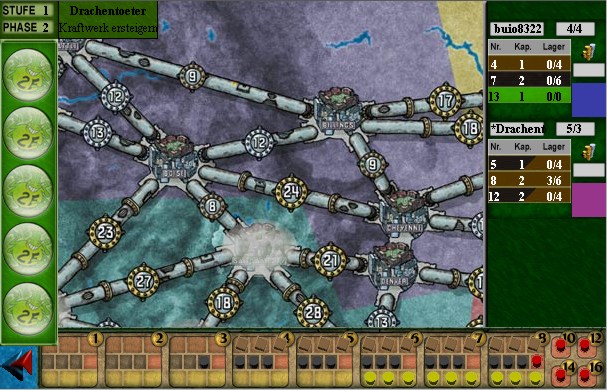
Each player represents a group that produces electricity through power plants and supplies cities through the development of a power grid. During the game, power plants are first refused and raw materials are bought for electricity generation. At the same time, it is necessary to ensure that the power grid is expanded to provide electricity to a growing number of cities.
Help in the field
Player display
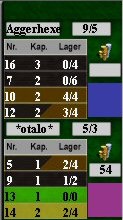
Right next to the field, all players are displayed. In addition to the name, there is the capacity and number of connected cities. Aggerhexe could therefore currently provide nine cities, but only five have connected.
These include the player's power plants. The colors are each for the raw material to be processed, a tool tip also displays the raw material again. The first number is the number and at the same time the minimum bid for this power plant, the second shows the capacity (how many cities can be supplied with this power plant). The last number pair describes the number of stored raw materials/storage capacity of the power plant.
On the right side of the power plants, the player color and the fortune are displayed. The latter one only sees oneself, the fortune of the fellow players remains hidden.
Button bar
In the button bar left next to the field, useful helpers hide. The individual functions that hide behind the buttons are explained at a given point. Here is a short overview:

Power plant market: opens automatically during the power plant auction. Otherwise, it can be opened here, for example, to see which power plants are to be expected for the upcoming round.
Power plant management: here you can view the power plants of each player. Alternatively, the power plant administration will also open by clicking on the corresponding player name in the player display.
Calculator: This enables the cost of raw materials, power plants or city connections to be quickly exceeded.
Paytable: here you will see how much money you receive at the end of a round for a certain number of connected cities.
Table of replenishment: it shows how many raw materials from which variety per round are placed on the market.
All windows can be closed with the red button at the top right, unless they are just necessary for the current phase.
Game sequence

The current stage and phase, as well as the currently active player and its action to be performed, are displayed at the top left of the field.
The game runs over three stages, each stage can have different rounds. Each round always consists of six phases:
- Defining the game sequence
- Power plant auction
- Buying raw materials
- Urban development
- Fire
- Income and refilling of the raw materials market
Defining the game sequence

The game order is redefined at the beginning of each round. It is a fundamental and very important element of the game. It is displayed to the right of the field duch the arrangement of the player names. The top player is the best and therefore the first, etc. Here, Bester becomes, who has joined most cities so far (see below). With the same number, the highest power station number of players decides as Tiebreaker.
Only in round 1 the order is redefined once after phase 2 (force auction).
Power plant auction
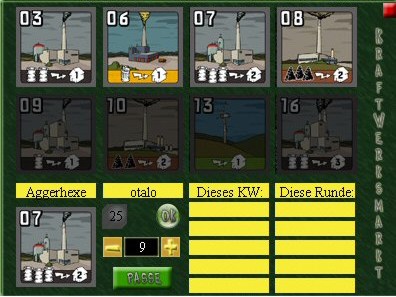
Each player receives 50 electric (money units) starting capital at the beginning.
There are always eight power plants, of which only the top row can be purchased in stages 1 and 2. At the beginning of the game, the power plants are always 3,4,5,6,7,8,9 and 10; as the first power plant, the 13 will always succeed. With two and three players, eight power plants were accidentally removed at the beginning, with four players there are only four power plants.
The power plants are always sorted by minimum requirements (the number in the upper left corner). At the bottom of the power plants are the raw materials that must be burned and the number of cities that can be supplied with this power plant. There are the following types of power plants:
- Carbon (brown)
- Oil (black)
- Hybrid (black/brown - can be fired with oil and/or coal)
- Trash (yellow)
- Uranium (red)
- Eco (green - does not need raw materials)
- Fusion (blue - does not need raw materials)
The best player in the game order must always offer a power plant first. Only power plants of the upper row may be offered (as long as not level 3 is reached - see below). The player clicks on the power plant, if necessary increases its bid by "+" and clicks "OK". Now the other players can increase or match the game order. Once you have been fit, you can no longer join the current power plant. Whoever fits, if he has to propose a power plant, can no longer purchase a power plant. The highest bidder receives the power plant. If he already has three (at two players four) power plants, he must tear off an existing one (see below).
A power plant is withdrawn and the number is sorted between the others. The now best-placed player, who has not yet acquired a power plant in the current round and is still allowed to purchase one, must now propose a power plant next.
If all players have been fitted and no power plant has been purchased in this round, the cheapest power plant comes from the game.
Destroying power plants
If a power plant has to be pulled off to create space for a newly acquired power plant, the raw materials of the old power plant are automatically taken over for the new power plant if it can process the same raw material and has sufficient storage capacity. Otherwise, the raw materials can be redistributed to other, own power plants before they are torn off, provided they can store the same raw material. If you don't have a power plant that can take up the raw materials, they will fall.
A rare special case can arise if one of the smaller hybrid power plants (5, 12 or 21) is to be superstructured with power plant 29 and more than two different raw materials are stored on the old power plant. Since the 29-power plant can store only two raw materials, the player must now decide which raw materials he wants to release - if he otherwise does not have a power plant that can absorb coal or oil. To this end, the power plant manager opens and the following selection is obtained:
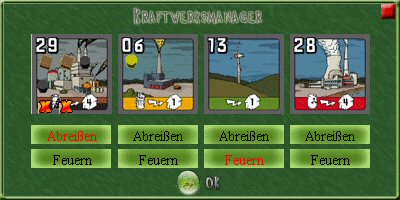
As you can see, the player has four raw materials from the previous power plant (5,12 or 21), but now only two raw materials can be stored because power plant 29 has only one capacity of two. Since none of the other power plants can absorb coal or oil, two raw materials must be disposed of.

To do this, you simply place the yellow-red crosses over the raw materials to be disposed of.
Buying raw materials
Players now buy the raw materials they need to fire their power plants. Each power plant must store only the raw materials that it can burn. A power plant can store a maximum of twice the amount of raw materials that it can burn per round.

The raw material market is divided into eight large blocks, each of which can store three wood, coal and garbage, as well as one uranium. On the right, there are four other camps for uranium. The number on each block indicates the costs for the raw materials stored there. In the beginning, the first three woods each cost an electric, the first three oil per three electrics. For uranium one would have to pay at the beginning 14 electrics.
In this phase, the worst player may begin. It therefore has the largest selection and can secure the cheapest raw materials. It simply clicks on the desired raw materials on the market and confirms the purchase by clicking on the green button. If it happens, you have either exceeded your capacity or assets. Reihum to the best player now buy all others their raw materials. If there are not enough raw materials of a variety on the market, one has had bad luck and should take this into account in the further rounds when buying power plants.
To get an overview of its power plants, it is recommended to open the power plant manager here (second button of the button bar or click on its own name).
Urban development
For 2/3/4/5/6 players, 3/3/4/5/5 connected areas are played. In the inactive areas, cities are covered by clouds.
Again, starting with the worst player, cities can now be connected to the power supply.
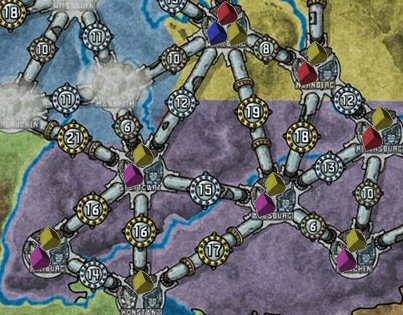
In the first round you can start in any city. This is simply clicked in the phase. All other cities must be connected from there. It should be noted that in Level 1 of each city only a players may be connected; from level 2, second terminals are then possible, in level 3, up to three players are allowed to supply a city. One player must not join the same city twice.
Connection costs and pipeline costs must be paid for each city to be connected. The connection costs are 10 electric for a first connection, 15 for the second connection and 20 for the third. The pipeline costs are indicated on the pipes connecting the cities and are added to the connection costs.
Thus, Violet would pay in the picture from the city to the bottom right 14 (Pipeline) + 15 (second connection) = 29 electric. Blue could build up on the cheapest right and would have to pay 8 (pipeline) + 20 (third connection).
It is also possible to skip cities or to build them under occupied cities; only the corresponding pipeline costs and the connection costs of the last city are to be paid. To connect a city you simply click on it - the cheapest way is determined automatically - and confirmed with "OK".
Once a player has connected X cities in this phase, all power plants with minimum bid of less than or equal to X are taken from the market and removed.

As a small computer, you can find the computer in the button bar as a third button. This allows you to calculate the costs for the cities to be connected. To do this, the computer is opened and simply click on the desired cities. The whole also works for power plants and raw materials. For example, while waiting for the trains of the fellow players, you can calculate how many raw materials you can buy and how many connections the money is still enough. If you click "/Reset" in the window below, the data will be deleted and you can set a new calculation. In order to avoid unplanned construction, cities can only be closed computer join!
Fire
In order to get money, the connected cities must now be supplied with electricity. To this end, it is necessary to fire its power plants with the raw materials previously purchased.
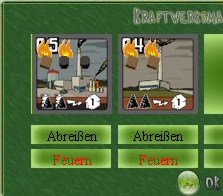
The power plant manager opens automatically and shows its own power plants with the stored raw materials. Now you click on the "Fire" button at the appropriate power plants to supply at least all connected cities. The raw materials, which are fired for this purpose, receive a bottle. In the case of hybrid power plants, it is possible to decide by moving the flakes which of the stored raw materials is to be fired. If you select everything as desired, click "OK".
Income and filling up the raw material market

According to the number of supplied Cities each player receives a certain number of electric after firing. The paytable can be called via the button bar (fourth button).
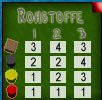
The raw materials are then placed on the market. The delay varies depending on the level and number of players. An overview of this gives the raw material table that can be called with the bottom button of the button bar.
In rare cases, there are not enough raw materials for refilling. Then less raw materials are refilled accordingly.
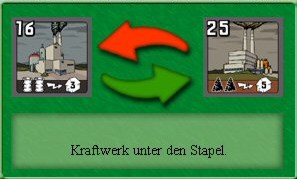
At the end of each round, the highest power plant is removed on the market and pushed back under the stack. For this, a new one is inserted from the draw-up stack.
The individual stages
As mentioned, the game consists of three stages.
First stage
Every city can only a Players are connected.
Second stage
The second stage begins as soon as 10/7/6 cities were connected to 2/3-5/6 players. The cheapest power plant is taken from the power plant market and removed. From now on, second terminals are possible.
Third stage
At the beginning of the game, the "step 3" card is pushed under the draw-up stack as the lowest card. As soon as it is revealed in the game, step 3 begins. Now the cheapest power plant is removed again, third-party connections are now possible. In addition, the power plant market All to be traded out of existing power plants.
Playing
The game ends when at least one player has joined 21/17/17/15/14 cities at 2/3/4/5/6.
It wins the player who can supply the most cities with electricity during the subsequent firing, so not forcibly the player who has also connected most cities!
If several players can provide equal numbers of cities, the fortune decides.
Options
map
There are five possible schedules: USA, Germany, France, Italy, Baden-Württemberg. These will be either via the game tool selected or by /option map 1/2/3/4/5 (/option map 3 would then be France).
USA and Germany work as described in the instructions. Italy and France have a somewhat different distribution of the raw material market at the beginning of the game:

raw material market Italy

raw material market France
As is known, in France, the atomic current is more estimated than in Germany, but ecocurrent is completely unknown. Therefore, in France, the 13th ecological car is taken out of play, its role takes on the 11th uranium.
EnBW Edition
The EnBW edition differs from the rules of the other editions in the following points:
The player order is redefined in each round after the phase of power plant auction, not only in round 1.
Each area consists only of six cities, the seventh city is always a so-called supraregional city. It can only be connected in stage 2 at the cost of a second connection.
Level 2 therefore begins a city earlier than on the other cards.
setmap
By means of a binary code, you can choose the desired areas yourself. The following shall apply:
USA: green|braun|rot|gelb|türkis|lila
Germany: lila|blau|gelb|rot|braun|türkis
France: lila|rot|türkis|gelb|braun|blau
Italy: brown|lila|rot|gelb|türkis|blau
Baden-Württemberg: red|gelb|türkis|lila|blau.
Example: If you want to play the US card with green, red and yellow, you only activate the US card (see /option map) and then enter the following line in the main chat: /option setmap 101100
Tactical tips
- The sequence of seats is extremely important in this game. If you are looking forward from the start, you must always buy expensive raw materials and offer them first for the power plants. That's why it's better to stay a little further behind
- Always keep an eye on the power plants of the opponents and their raw material requirements. If many players have the same raw material requirement, it can easily become narrow on the market. Who then lies ahead and has to buy as the latter often looks into the tube
- In the selection of power plants, the market and the raw material requirements of the co-players already have an eye. It's especially important against gaming. Very annoying when the co-players buy the raw materials away from the nose, so you can't provide enough and lose the game despite perhaps most cities. So check for alternatives in time.

